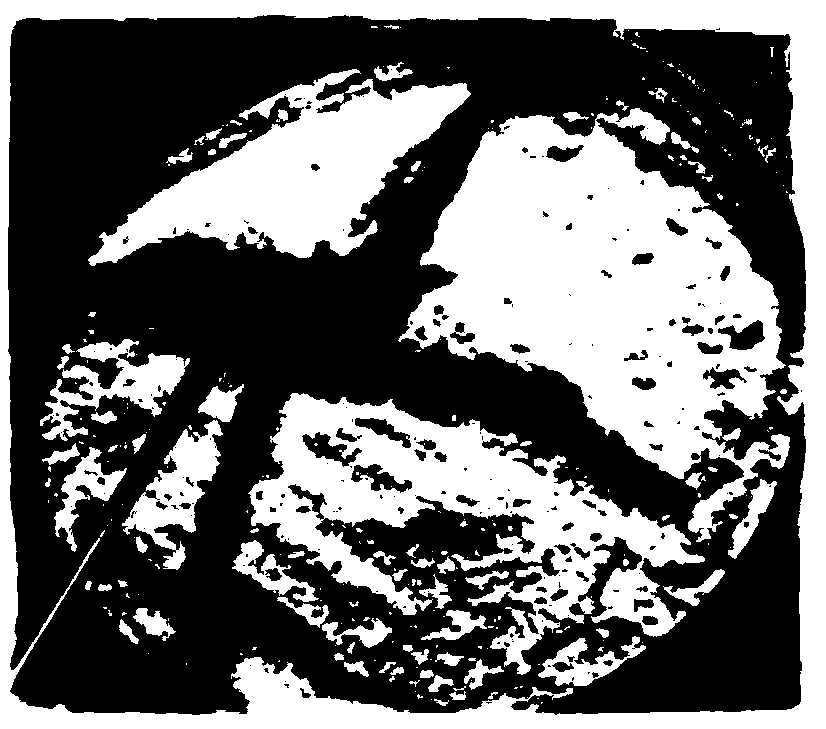Extracellular polysaccharide lysobacter SCSIO 17111 with sand fixation effect and application thereof
A technology of SCSIO17111 and lysobacteria, which is applied in the field of microorganisms to achieve the effects of low cost, quick effect and strong adaptability
- Summary
- Abstract
- Description
- Claims
- Application Information
AI Technical Summary
Problems solved by technology
Method used
Image
Examples
Embodiment 1
[0017] Example 1: Isolation of Lysobacter sp. SCSIO 17111
[0018] 1. Sample collection
[0019] The biological soil crust samples were collected from the South China Sea Islands in November 2016. After the sample is collected, it is quickly put into a sterile polyethylene sampling bag, dried in the shade, and stored at room temperature.
[0020] 2. Separate the medium
[0021] The separation medium is TSA (tryptic soy agar) medium: commercial product (BD), tryptone 15.0g / L, soy peptone 5.0g / L, sodium chloride 5.0g / L, agar 15.0g / L, solvent It is water, pH 7.3±0.2. The preparation method is to mix the above-mentioned components uniformly according to their contents, adjust the pH value to pH 7.3±0.2, and then sterilize and disinfect.
[0022] 3. Separation and screening of strains
[0023] Thoroughly grind and mix the crust sample, then take 2g of it and place it in an Erlenmeyer flask containing 18ml of sterile deionized water. In the Erlenmeyer flask, there are some sterilized small ...
Embodiment 2
[0026] Example 2: Determination of the production of extracellular polysaccharide of Lysobacterium SCSIO 17111
[0027] The Lysobacterium SCSIO 17111 was inoculated into TSB medium (BD). The medium components were tryptone 17.0g / L, soy peptone 3.0g / L, glucose 2.5g / L, sodium chloride 5.0g / L, K 2 HPO 4 2.5g / L, the solvent is water, and the pH is 7.3±0.2. The preparation method is to mix the above ingredients evenly according to their content, adjust the pH value, and then sterilize it. Cultivate for 45 hours at 30°C and 180r / min. The culture solution was centrifuged at 11603 g for 20 minutes to remove the bacteria, and then the supernatant was filtered through a 0.22 μm filter membrane to fully remove the remaining microbial cells. Then pour the filtrate into a test tube, add 4 times the volume of a 95% ethanol aqueous solution with a volume fraction, and precipitate overnight at 4°C. Then the mixture was centrifuged at 2057g for 20min, the supernatant was removed, and the precipi...
Embodiment 3
[0029] Example 3: Determination of Sand-fixing Ability of Lysobacterium SCSIO 17111
[0030] Pass the coral sand through 16 mesh (1.25 mm mesh) and 80 mesh (0.20 mm mesh) sieves to obtain coral sand with a particle diameter of less than 1.25 mm and greater than 0.20 mm and coral sand with a particle diameter of less than 0.20 mm. They were placed in different petri dishes, and 3 replicates were made for each type of sand, and then sterilized at 121°C for 25 minutes, dried in an oven at 60°C, and mixed until loose and uniform. The Lysobacterium SCSIO 17111 was inoculated into TSB medium (same as Example 2). After shaking culture for 48 hours under the conditions of 30°C and 180r / min, the bacteria solution was placed in a sterile small watering can and sprayed evenly on the coral sand Above, use sterilized TSB medium as a blank control. After culturing at 30°C for 55 days, the thickness of the crust was measured. The test results show that Lysobacterium SCSIO 17111 can effectivel...
PUM
| Property | Measurement | Unit |
|---|---|---|
| thickness | aaaaa | aaaaa |
| particle diameter | aaaaa | aaaaa |
| particle diameter | aaaaa | aaaaa |
Abstract
Description
Claims
Application Information
 Login to View More
Login to View More - R&D
- Intellectual Property
- Life Sciences
- Materials
- Tech Scout
- Unparalleled Data Quality
- Higher Quality Content
- 60% Fewer Hallucinations
Browse by: Latest US Patents, China's latest patents, Technical Efficacy Thesaurus, Application Domain, Technology Topic, Popular Technical Reports.
© 2025 PatSnap. All rights reserved.Legal|Privacy policy|Modern Slavery Act Transparency Statement|Sitemap|About US| Contact US: help@patsnap.com


